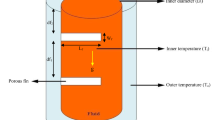Abstract
The present study reports the effect of several operating parameters on the thermal performance of the vortex tube. The experimental results indicate that the inlet pressure and the cold fraction are the most significant parameters influencing the vortex tube performance. The experimental data point out that insulation has minimal effect on the vortex tube performance. The same inlet pressure tests show that energy separation increases as number of inlet nozzle increases.







Similar content being viewed by others
Abbreviations
- COP:
-
Coefficient of performance
- D :
-
Vortex tube inner diameter, m
- h :
-
Enthalpy, kJ/kg
- P in :
-
Inlet pressure, bar
- \( \dot{m}_{h} \) :
-
Hot mass flow rate, kg/s
- \( \dot{m}_{c} \) :
-
Cold mass flow rate, kg/s
- \( \dot{m}_{in} \) :
-
Inlet mass flow rate, kg/s
- RHVT:
-
Ranque–Hilsch vortex tube
- T h :
-
Hot outlet temperature, °C
- T c :
-
Cold outlet temperature, °C
- T in :
-
Inlet temperature, °C
- ΔT h :
-
Temperature difference between the inlet and the hot outlet, ΔT h = T h − T in
- ΔT c :
-
Temperature difference between the inlet and the cold outlet, ΔT c = T in − T c
- \( \epsilon\) :
-
Cold mass fraction; \( \varepsilon = \dot{m}_{c} /\dot{m}_{in} \)
References
Ranque GJ (1933) Experiments on expansion in a vortex with simultaneous exhaust of hot air and cold air. J Phys Radium (Paris) 4:112–4 S-115, June. Also translated as General Electric Co., Schenectady Works Library 1947; T.F. 3294
Ranque GJ (1934) Method and apparatus for obtaining from a fluid under pressure two outputs of fluid at different temperatures. US patent 1:952,281
Hilsch R (1947) The use of the expansion of gases in a centrifugal field as cooling process. Rev Sci Instrum 18(2):108–113
Eiamsa-ard S, Promvonge P (2008) Review of Ranque–Hilsch effects in vortex tubes. Renew Sustain Energy Rev 12:1822–1842
Lewins J, Bejan A (1999) Vortex tube optimization theory. Energy 24:931–943
Eiamsa-ard S, Wongcharee K, Promvonge P (2010) Experimental investigation on energy separation in a counter-flow Ranque–Hilsch vortex tube: effect of cooling a hot tube. Int Commun Heat Mass Transf 37:156–162
Nimbalkar SU, Muller MR (2009) An experimental investigation of the optimum geometry for the cold end orifice of a vortex tube. Appl Therm Eng 29:509–514
Dincer K, Baskaya S, Uysal BZ, Ucgul I (2009) Experimental investigation of the performance of a Ranque–Hilsch vortex tube with regard to a plug located at the hot outlet. Int J Refrig 32:87–94
Dincer K, Tasdemir S, Baskaya S, Uysal BZ (2008) Modeling of the effects of length to diameter ratio and nozzle number on the performance of counterflow Ranque–Hilsch vortex tubes using artificial neural networks. Appl Therm Eng 28:2380–2390
Aydın O, Baki M (2006) An experimental study on the design parameters of a counterflow vortex tube. Energy 31:2763–2772
Gao CM, Bosschaart KJ, Zeegers JCH, de Waele ATAM (2005) Experimental study on a simple Ranque–Hilsch vortex tube. Cryogenics 45:173–183
Xue Y, Arjomandi M (2008) The effect of vortex angle on the efficiency of the Ranque–Hilsch vortex tube. Exp Therm Fluid Sci 33:54–57
Wu YT, Ding Y, Ji YB, Ma CF, Ge MC (2007) Modification and experimental research on vortex tube. Int J Refrig 30:1042–1049
Piralishvili SA, Polyaev VM (1996) Flow and thermodynamic characteristics of energy separation in a double-circuit vortex tube an experimental investigation. Exp Therm Fluid Sci 12:399–410
Behera U, Paul PJ, Dinesh K, Jacob S (2008) Numerical investigations on flow behavior and energy separation in Ranque–Hilsch vortex tube. Int J Heat Mass Transf 51(25–26):6077–6089
Behera U, Paul PJ, Kasthurirengan S, Karunanithi R, Ram SN, Dinesh K, Jacob S (2005) CFD analysis and experimental investigations towards optimizing the parameters of Ranque–Hilsch vortex tube. Int J Heat Mass Transf 48:1961–1973
Eiamsa-ard S, Promvonge P (2007) Numerical investigation of the thermal separation in a Ranque–Hilsch vortex tube. Int J Heat Mass Transf 50:821–832
Aljuwayhel NF, Nellis GF, Klein SA (2005) Parametric and internal study of the vortex tube using a CFD model. Int J Refrig 28:442–450
Acknowledgments
The authors would like to acknowledge the support provided by United Arab Emirates University. This work was financially supported by the Research Affairs at the United Arab Emirates University under a contract no. 01-05-7-11/09.
Author information
Authors and Affiliations
Corresponding author
Rights and permissions
About this article
Cite this article
Hamdan, M.O., Alawar, A., Elnajjar, E. et al. Experimental analysis on vortex tube energy separation performance. Heat Mass Transfer 47, 1637–1642 (2011). https://doi.org/10.1007/s00231-011-0824-6
Received:
Accepted:
Published:
Issue Date:
DOI: https://doi.org/10.1007/s00231-011-0824-6




